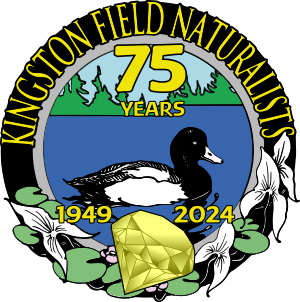by Sharon David
Introduction

In this article I will discuss the trees and shrubs that you can plant in your yard to enhance it’s wildlifeness and which will provide a natural food source for wildlife during the fall and winter months.
Many people view trees and shrubs as privacy barriers and shade sources, and often forget the benefits and beauty of plants which produce seeds or fruit which remain into the harsh winter months which are required by wildlife for winter survival. The KFN’s Winter Foods and Shelter for Wildlife Garden demonstrates plantings for wildlife which would aide in their survival during the winter months, and can be used as a model plot from which one could view beneficial plants in a natural setting, which could then be incorporated into your gardens. I will now discuss many of those plants and their benefits to wildlife and hope that you will plant some of these in your garden.
Although new plantings of trees and shrubs may take many years for them to attain their size and complete productiveness, they will ensure a varied habitat that is required for birds and many mammals to survive our harsh winters. In the next issue of Blue Bill I will go over annuals and perennials that can be planted from which birds and insects will benefit.
Planning Your Layout
How do you develop your backyard into a sanctuary for birds and animals of winter? There is unfortunately one major drawback to any plan that you might have, which is that if you live in a new development where there are few large trees or no trees for many blocks, no matter how many trees and shrubs you might plant, they will not be enough to maintain a wildlife population. You would be an island of green in the middle of houses, similar to an island in the middle of a large lake. What would result is that birds and animals passing through your area follow what are called corridors. Wildlife follow paths of green — hydro and gas lines, railway lines, and tracts of forest — which take them from one habitat to the next, or move them north to south and back during migration. If you live in a relatively new development with very few trees I would suggest getting many of the local people involved and trying to get a community planting underway which would benefit all of you at once.
Planning your backyard habitat is the key to being successful in creating a diverse habitat which will appeal to many species. Try to remember to select plants which will provide food and shelter for a variety of species, and by choosing plants of different heights and growing patterns. Attempt to plant species that are native to our area as they will survive best since they will be adapted to the climate, soil conditions, local pests and disease. It is possible to create a wildlife sanctuary in the smallest of yards as well as on acres of land.

To begin your planning start by:
- mapping your yard to scale
- mapping the location of your house and other buildings and objects (pool, deck)
- plotting existing plants
- mapping out existing paths and patios
- locating power lines, pipes and underground cables. Don’t start major digging with consulting the utility companies to check for underground cables
Now start deciding on the types of plants you want to have and where you’d like to plant them and produce a preliminary plan (Figure 1).
You will probably need to go through several different layouts before deciding on a final one. While planning and concentrating on the benefits of a particular plant for wildlife you should also consider the size of the full grown plant, and it’s effect on the rest of your plantings in order to not have to cut the tree down when it reaches full maturity. Take into consideration the direction of the sun and the effect of any tall tree will have on shading, and if there is any view you want to maintain or hide. As well, your plan should alert you to where a tree’s large roots may damage a building.
How you arrange your plants is as important as what you plant. Wildlife congregates where two different habitats meet, called edges, so you should try and design your yard with alternating planting with open areas. There is landscaping software available for use on computers but I have yet to try any of them so I cannot recommend any. One suggestion is that you start watching some of the gardening shows that are available of PBS Saturday mornings that could give you ideas on how other people have planted similar gardens, or consult some of the many books available on the subject. In consulting books and television, don’t forget that they rarely take into account the benefits of the trees and shrubs to wildlife and often centre on the aesthetic appeal of a particular plant species.
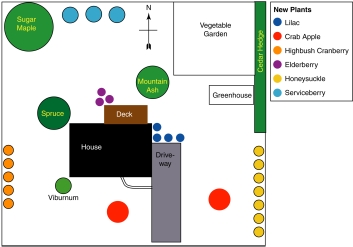
Now that you have a preliminary design in mind you can start to narrow down your choice of plants by consulting some books which will show what the plants look like full grown and their planting requirements. One book you should definitely consult if planning any major plantings is called Trees, Shrubs and Vines for Attracting Birds by R.M. DeGraaf and G.M. Witman2 (see reference list at the end). You might find yourself overwhelmed by the selection of plants available to you but decide on what type of birds or animals you want to attract and keep that in mind when doing your final selection. Appendix 1 lists the many plant species that grow best in this area and that are most beneficial to wildlife, and outlines the number of species that are attracted to them for food, shelter and nest sites, as well as noting a few species of interest. Some plant favourites include Highbush Cranberry, Elderberry, Crab Apple, White Pine, Sumac, Red-osier Dogwood, White Cedar, Mountain Ash, Honeysuckle, Maple, and Eastern Hemlock. From Appendix 1 I will summarize in the next section the plants marked with the plus (+) which I feel are plants that should be included in any improvement plan because of their overall attractiveness to wildlife. Again, keep in mind what these plants produce and when. Try and diversify your selection so that you have enough cover for use as shelter, and plants that keep berries and/or seeds into early fall, late fall, winter and those plants that are used as “starvation” or “last resort” foods (such as Highbush Cranberry). What will then result is a plan showing plant locations and existing structures (Figure 2).
Important Species Summaries:
The species outlined below are described in detail in Trees, Shrubs and Vines for Attracting Birds by R.M. DeGraaf and G.M. Witman2. The descriptions below include a brief description of important features, height at maturity, fruits produced, fruiting period important as an indication as to whether fruit will remain into the harsh winter months from January to March), and landscape or other notes. These are meant as a starting point, so you should consult more detailed books if you plan on doing major landscaping.
Evergreens:

Hemlock, Eastern: Tolerant of shade, and attains heights of 60-70 feet. Attracts 9 species for food, 22 for shelter, and 15 for nesting. Is preferred nest site of the robin, blue jay, and wood thrush. The seed is eaten by crossbills, chickadees, pine siskins, and goldfinches. Fruits are small cones ½ to ¾-inch long, from September to October, and persist through winter. Hardy and grows best in deep, moist, well-drained soil in full sun or dense shade. Does poorly in cities.

White Pine: The rapid growth ability makes it ideal wildlife cover, attaining heights to 100 feet. Attracts 38 species for food, 34 for shelter, and 31 for nesting, making it the most valuable of all wildlife species listed here, especially as shelter from the elements. It is a frequent nest site for robins, mourning doves, and blue jays. Fruits are cones, 4 to 8 inches long from August to September, and fall from the trees in winter or spring. Grows on a variety of sites, but prefers moist, sandy loams.
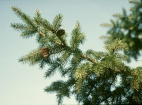
Spruce (Red or White): Are hardy, rapid growing, reaching 18 feet in ten years, and can grow to 100 feet. They attract 21 species for food, 31 for shelter and 27 for nesting, making it the second most important evergreen for shelter for wildlife. It is a favourite nest site for robin, mourning dove, mockingbird, and chipping sparrow. The seed is choice food of crossbills and other finches. Fruit are cones, 1½-inches long, from August to November, but they drop soon after maturing. Long, single or double rows or trees make excellent windbreaks, and form effective screens against unsightly views. Suggested for larger properties only.
Deciduous Trees:
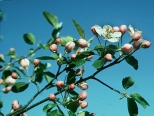
Apple, Crab: Small trees, less than 30 feet tall. They are the most commonly planted ornamental tree, that attract 27 species for food, 10 for shelter and 14 for nesting. Fruits vary in size from ¼-inch to 2-inches depending on the species and are dark red to yellow in colour, peaking in September and October, and drop to the ground in the months after. Try and get Makamik which is a smaller apple and which stays on the tree throughout the winter. Due to the attractiveness of crab apples there are so many varieties available that you should be careful to get one with small fruit, that is not too hard for the birds to tear, and the species description should specify that it is attractive to wildlife and retains fruit into the winter.
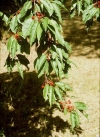
Cherry (Black and Pin): Pin Cherry is a small tree, 10 to 30 feet tall, and Black Cherry attains heights to 60 feet. The fruits of cherry is the valuable of the bird food attracting over 46 species, and are especially attractive for eastern bluebird. Oriole, Robin and kingbird are the only species that will generally nest in Black Cherry. Fruits are small, red (Pin) or dark purple (Black), and are edible to humans as well as wildlife, and ripen from July to September and sometimes persist into the winter (more dependent on the birds removing the fruit before winter than other factors). Both cherries should be planted in an area where the falling fruit will not cause any problems, like not being planted close to a walkway or driveway. Both are hardy, but Pin Cherry is a frequent host of webworm and tent caterpillar.
Chokeberry, Common: This is a small, hardy, rapid growing tree, attaining heights to 20 feet. It’s small, purplish-black fruit is consumed by over 43 species, and preferred especially by eastern bluebirds. Fruiting period is July to October, with few fruits persisting past then due to their high attractiveness to birds. This tree is useful for small properties.
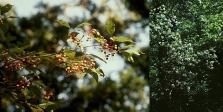
Dogwood, Flowering: This is a small, slow growing tree, rarely over 40 feet tall. It is a widely used landscape plant and it’s fruits are eaten by more than 100 species of birds. The scarlet fruit ripens from August to November with fruits persisting through to winter. This is a highly suggested tree for any landscape garden.
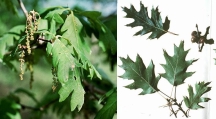
Oak (White, and Northern Red): Both are valuable timber trees, slow growing, and reaching heights to 90 feet. White Oak’s ½- to ¾-inch acorns are choice food of the blue jay, ruffed grouse, and brown thrasher, while Red Oak’s ½- to 1-inch acorns are preferred by grackles, ruffed grouse, and turkey. Fruits ripen from September to November and persist to December. Both Oaks generally start to fruit at twenty years with heavy crops occurring after their fortieth year.
Serviceberry (Juneberry): These are small trees reaching heights to 40 feet. The sweet purple fruits ripen early (June to August) and are preferred by many birds, like mockingbird, rufous-sided towhee, cardinal, rose-breasted grosbeak, oriole, thrasher, catbird and ruffed grouse. Serviceberry makes an excellent tree for a small yard, growing well in sun or shade, with best fruit production if grown in full sun.
Deciduous Shrubs:
Cranberry, Highbush: This hardy, fast growing shrub grows to 15 feet and is used by birds as emergency or “starvation food”, which makes it highly beneficial to birds in years when food is scarce and the berries have been depleted off of the choice plants with cranberry left. Cranberry attracts 32 species to its fruit, 15 for shelter and 2 for nesting. The fruit is bright orange to red, and are colourful when the leaves drop in fall, and persist all winter.
Elder, American (Elderberry): This is a hardy shrub, growing to 12 feet, and capable of withstanding heavy pruning. The small, juicy berries are relished by over 33 species, and the juice is often used for wines and jellies. Fruits are borne on two-year old canes and ripen from July to September, but rarely persist beyond because of their high attractiveness. Individual canes die between their third and fifth year and need to be removed. This shrub is so attractive to birds that no garden should be without one.
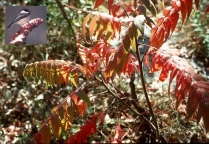
Sumac, Staghorn: This is a hardy, rapid growing shrub or small tree. It attracts 31 species to its fruit, and 4 for shelter. The fruit are hairy red and ornamental, produced in August and September and persist through winter. This is a heavily used species for spring migrating robins as a food source, as well as to chickadees. Sumac tolerates poor soil, and grows best where its canopy can spread freely. Once established it reproduces abundantly by underground sucker shoots, so keep that in mind for where you want to plant it.
Winterberry, Common: This is a widespread, slow-growing holly of New England, often called Black Alder, which is becoming more valued for its ornamentalness. It can grow to 15 feet, and is striking when the leaves fall in the fall leaving it’s exposed red fruit which persist into winter. As this is a holly, male and female plants should be located within 40 feet for best cross-pollination and fruit production. Plants three to five years old will start bearing fruit.
Sources of Plants
Many species that I have mentioned can be purchased at local nurseries. There are mail order nurseries which sell bare-root plants (plants that are shipped with their roots not in soil) in early spring at greatly reduced prices of professional nurseries, and are highly recommended if you are ordering large quantities of plants. Most come with written guarantees that they will grow, so you should make sure that type of guarantee is available since trees and shrubs are a little more difficult to get established than annuals or perennials. The magazine Harrowsmith Country Life is an excellent source for mail order sources for trees and shrubs and should be consulted in late winter – early spring for addresses of Ontario sources. Several of the evergreens, trees and shrubs can be purchased from the Ministry of Natural Resources tree farms for about 10¢ per plant (in bundles of 50 plants per species) if you own more than 5 acres of land, and are 2 year old plants. These do not come with any guarantee, but are highly recommended if you are reforesting large tracts of land, as you can intermix different aged trees and shrubs to obtain a diversely aged habitat. Trees must be ordered well in advance in early to late winter if you want to guarantee certain species.
References:
- Federation of Ontario Naturalists. Backyard Habitats. FON: Toronto.
- DeGraaf, R.M. and G.M. Witman. 1979. Trees, Shrubs, and Vines for Attracting Birds. University of Massachusetts Press: Amherst.
Suggested Reading:
- Dennis, J.V. 1985. The Wildlife Gardener. Alfred A. Knopf: New York.
- Ernst, R.S. 1987. The Naturalists Garden. Rodale Press: Emmaus Pennsylvania.
- Harrison, K. and Harrison, G. 1990. The Birds of Winter. Random House: New York.
- Hosie, R.C. 1979. Native Trees of Canada, 8th Edition. Environment Canada: Ottawa.
- Johnson, L. 1995. The Ontario Naturalized Garden: The Complete Guide to Using Native Plants. Whitecap Books: Toronto.
- Martin, A.C., H.S. Zim and A.L. Nelson (1951). American Wildlife and Plants: A Guide to Wildlife Food Habits. Dover Publications: New York.
- Merilees, B. 1989. Attracting Backyard Wildlife: A Guide for Nature Lovers. Whitecap Books: Toronto.
| Plant Species | Bird Usage1 | Mammal Use (Food)2 | Notable Species | ||
|---|---|---|---|---|---|
| Food | Shelter | Nesting | |||
| Evergreens: | |||||
| Cedar, Red | 28 | 21 | 8 | — | Robin*;Waxwing*;Bluebird* |
| Cedar, White | 3 | 2 | 2 | 12 | Siskin* |
| Fir, Balsam | 13 | 19 | 12 | 8 | Grosbeak*; Purple Finch* |
| Hemlock, Eastern+ | 9 | 22 | 15 | 7 | Siskin*; Goldfinch*; Grosbeak* |
| Juniper, Common | 14 | 4 | 1 | 6 | Robin*; Bluebird*; Grosbeak* |
| Pine, Pitch | 30 | 20 | 16 | 10 | Chickadee*;Nuthatch*;Creeper* |
| Pine, White+ | 38 | 34 | 31 | 6 | Chickadee*, Robin*, many! |
| Spruce+ | 21 | 31 | 27 | 7 | Siskin*;Nuthatch*;Crossbill* |
| Deciduous Trees: | |||||
| Apple, Crab+ | 27 | 10 | 14 | 12 | Robin*; Waxwing*; Grosbeak* |
| Birch | 23 | 10 | 15 | 7 | Siskin*; Goldfinch* |
| Butternut | 12 | 1 | 1 | 3 | Chickadee*; Nuthatch* |
| Cherry, Black+ | 46 | 2 | 4 | 13 | Vireo*; Oriole*;Cardinal*, etc. |
| Cherry, Pin+ | 43 | — | — | 13 | Flicker*;Kingbird*;Thrushes* |
| Chokecherry, Common+ | 43 | — | — | 13 | Catbird*; Thrasher*; Thrushes* |
| Dogwood, Flowering+ | 37 | — | 1 | 10 | Sapsucker*; Thrush*, many! |
| Hickory | 18 | 2 | 2 | 8 | Nuthatch*; Towhee* |
| Maple | 12 | 8 | 8 | 10 | Grosbeak*; Purple Finch* |
| Mountain-Ash, American | 15 | — | — | — | Robin*; Thrasher*; Waxwing* |
| Oak+ | 29 | 4 | 5 | 13 | Blue Jay*; Thrasher* |
| Serviceberry+ | 26 | 5 | 3 | 10 | Thrasher*; Thrush*; Cardinal* |
| Deciduous Shrubs: | |||||
| Alder | 15 | 16 | 10 | 7 | Redpoll*; Siskin*; Goldfinch* |
| Bayberry, Northern | 25 | 1 | 1 | 2 | Bluebird*; Meadowlark* |
| Cranberry, Highbush+ | 32 | 15 | 2 | 7 | Grouse*; Thrasher* |
| Dogwood, Red-osier | 18 | 3 | 1 | 7 | Kingbird*; Thrasher*; Robin* |
| Elder, American+ | 33 | 26 | 5 | 8 | Thrushes*;Waxwing*;Bluebird* |
| Hawthorn | 19 | 7 | 7 | 8 | Grouse*; Waxwing* |
| Honeysuckle | 21 | 9 | 3 | 3 | Catbird*; Robin*; Goldfinch* |
| Sumac, Staghorn+ | 31 | 4 | — | 4 | Thrushes*; Phoebe*; Bluebird* |
| Winterberry, Common+ | 28 | 4 | 4 | 1 | Mockingbird*; Catbird* |
1 Adapted from DeGraaf, R.M. and G.M. Witman (1979). Trees, Shrubs and Vines for Attracting Birds. Amherst: University of Massachusetts Press, 194 pp.
2 Adapted from Martin, A.C., H.S. Zim and A.L. Nelson (1951). American Wildlife and Plants: A Guide to Wildlife Food Habits. New York: Dover Publications, 500 pp.
+ Recommended Plants.
* Preferred Food.
